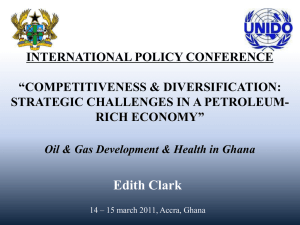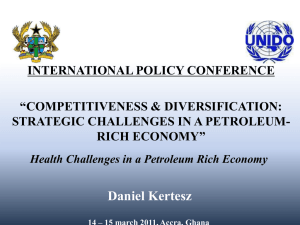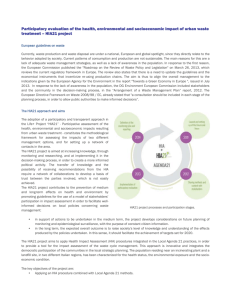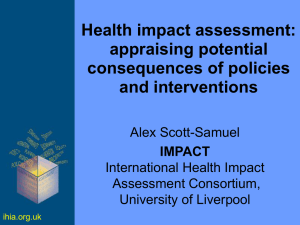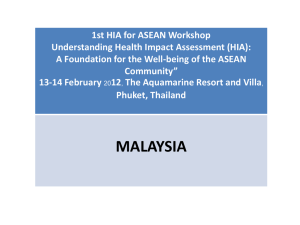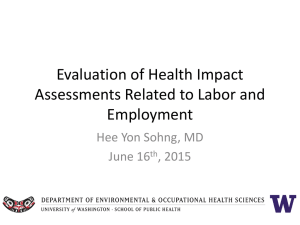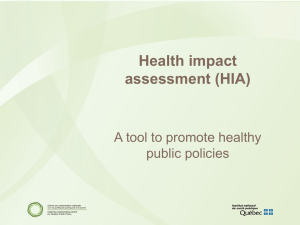No 40 by O'Mullane
advertisement
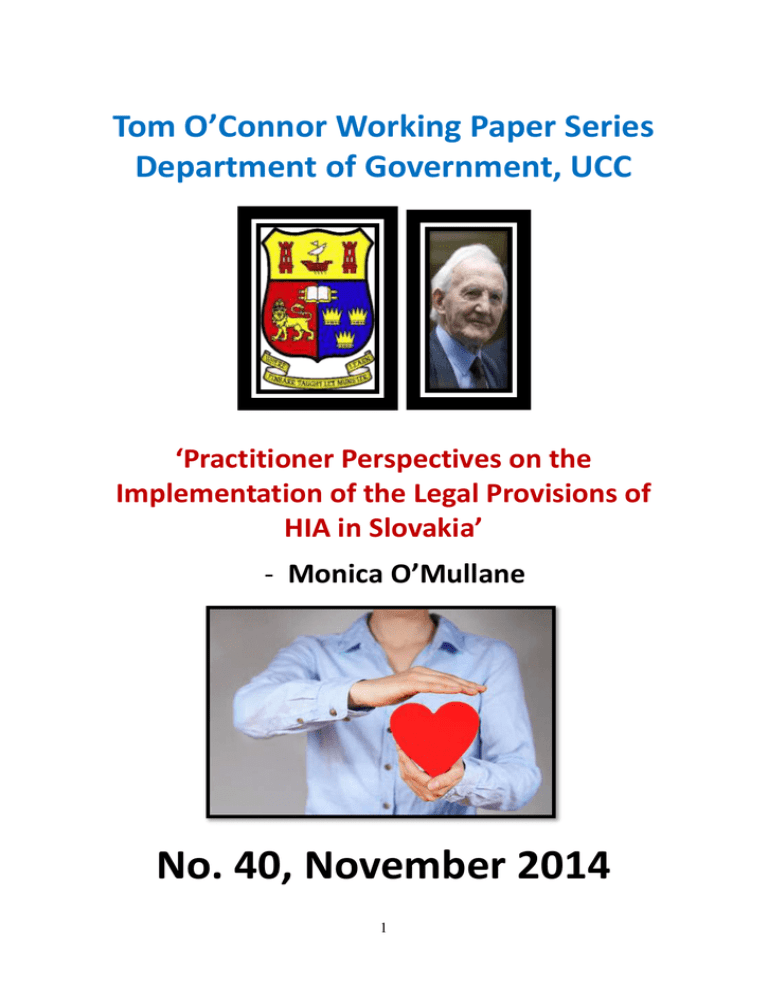
Tom O’Connor Working Paper Series Department of Government, UCC ‘Practitioner Perspectives on the Implementation of the Legal Provisions of HIA in Slovakia’ - Monica O’Mullane No. 40, November 2014 1 Practitioner Perspectives on the Implementation of the Legal Provisions of HIA in Slovakia Monica O’Mullane Department of Public Health, Faculty of Health Sciences and Social Work, Trnava University, Slovakia Introduction Health Impact Assessment (HIA) is an instrument and approach for assessing positive and negative health impacts of projects, programmes and policies. It was strongly cited in the 1990s as an instrument which could improve and inform public policy development1, and investigation into HIA has been ongoing with successful results. HIA practice and research has grown exponentially, over the past 2 decades in particular 2 3 4 5 6, stretching its practice and ethos across the globe7 8. It has been endorsed by international organisations such as the Organisation for African Unity (OAU), World Bank and World Health Organisation (WHO). It has been advocated by the WHO and E.U. as a tool for enabling Health in All Policies (HiAP). In 2008 the WHO Commission on Social Determinants of Health emphasised the suitability and necessity of HIA as a mechanism to promote and protect population health, especially in bridging the health equity gap9. HIA, with an equity focus, was cited in the Rio Political Declaration on Social Determinants of Health as being a necessary approach which would enable intersectoral action and dialogue across all sectors of government in order to promote and protect population health10. HIA is inherently multi-disciplinary, drawing from fields spanning the social, political, environmental health, spatial planning, public health and epidemiological sciences. This multidisciplinary characteristic enables HIA to be a useful instrument in advancing intersectoral action for health across public policy sectors. The purpose of this paper is to present an exploration of practitioner perspectives prior to the implementation of the Slovak legal provisions for HIA. This paper describes a part of a study carried out between March 2010 and September 2010, prior to the enforcement of the legal provisions for HIA, which commenced from January 1st 2011. Empirical data drawn from an open-ended questionnaire, which was administered to the Heads of Environment Health Departments (HEHD) in the 37 Regional 2 Public Health Authorities in Slovakia, will illustrate practitioner reflections regarding the then upcoming implementation. HIA in Europe The European Union’s clear obligation under the Amsterdam Treaty (1998) Article 152 is that all Community actions and activities would contribute towards a high level of health protection. Following on from the spirit of the Treaty’s words, the advancement of HIA within Europe has been steadily progressing albeit with varying degrees of implementation and institutionalisation across states. This was the conclusion of Wismar et al (2007) at the end of a 3-year multi-country project on the effectiveness of HIA, as carried out by the European Observatory on Health Systems and Policies11. Results showed that implementation and institutionalisation was incomplete in all countries included in the study, and as highlighted by Tarkowski and Riccardi (2012: 612), “none of these countries has strengthened and developed all the stewardship, funding, resource generation and delivery in full.” 12 Development of HIA as a stand-alone process or as one which has successfully integrated with other impact assessments (IAs) is comprehensively achieved in few countries. The Kyiv (SEA) Protocol provides an opportunity for further integration of the environmental and health IAs; what is required is political will and practicable circumstances for their integration. As announced at the HIA section of the European Union Public Health Association (EUPHA) during the conference in 2012 (Malta)13, the practice and research of HIA in Europe is continuing along a path of European cooperation and collaboration. HIA in Central Europe The assessment of health impacts in Central Europe has a long standing tradition within the public health services, with a strong focus on risk assessment. Additionally, the public health systems of Central Europe, especially those countries from the former Soviet bloc, were designed as public health safety care systems, developed from a biomedical orientation to public health and with a strong focus on the epidemiology of hygiene and sanitation. 14 The difficulty of institutionalising HIA, an instrument 3 that is recognised globally as one based on the social model of health15 and is driven to reduce health inequalities and inequities, is the tension between this underlying ethos of HIA and the more traditional biomedical perspective of public health systems across parts of Central Europe. This was also a conclusion of a study which examined and compared the implementation of HIA in two countries, Slovakia and Denmark. The social system, influenced as it is by the historical context, influences the implementation of HIA in Slovakia. 4 WHO Europe currently works with Government Ministries, most recently in Latvia 16 to develop HIA and to build capacity in HIA and its associated approaches such as health equity and the social determinants of health. A four-year EC-funded project, Risk Assessment from Policy to Impact Dimension (RAPID), examined risk assessment methodologies which could inform HIA and informed healthier public policies. This project included countries from across Europe, concluding in 2012. The main project result is that the RAPID guidance tool on policy risk assessment is based on the full chain approach. 17 HIA in Slovakia The story of HIA in Slovakia started at the beginning of the millennium with a number of projects that promoted the concept and underlying approaches, such as the PHASE European Commission project (Promoting and Supporting Integrated Approaches for Health and Sustainable Development at the Local Level across Europe, 2003 to 2005). In 2004 Slovakia provided a case study for the work of the WHO Europe publication series ‘HIA Toolkit for Cities.’ From 2005 to 2007 a Slovak partner was involved in the HIA NMAC project (Health Impact Assessment in New Member States and Pre-Accession Countries) and subsequently in the RAPID project (2009 to 2012). Much work has been motivated by the conclusion of the WHO Europe report for Slovakia (2008: 1)18, which recommended that “knowledge of and the methodology for health impact assessments should be improved; given the emphasis on the assessments in the new Public Health Act (2007), current procedures do not seem to be developed enough.” In February 2009 a workshop was organised by the Slovak Ministry of Health Care and by the WHO on HIA. The focus of this workshop, in building capacity of HIA highlighted the role of the social determinants of health, equity, policy appraisal and health impact assessment as feasible ways of promoting and protecting population health. 4 Through the implementation of the abovementioned projects, plus the work of the Ministry of Health, the National Public Health Authority (NPHA) and the WHO in building capacity for implementation of HIA in Slovakia (following the 2007 Public Health legislation), a great deal of work has been carried out in the country in order to enhance capacity in HIA . Factors such as social system, time and 19 availability of resources were identified as important factors for the implementation of HIA in Slovakia. 4 Public Health in Slovakia The Protection, Support and Development of Public Health Act (355/2007) was adopted in 2007 in the Slovak Republic. For the first time in the country, Health Impact Assessment (HIA) was made statutory- contained within legislation. Whether or not legislating for HIA would result in the effective and comprehensive implementation of HIA in a country is a topic of debate within the HIA community. The Slovak National Public Health Authority (NPHA) based in the Bratislava region, plus the 36 Regional Public Health Authorities, are responsible for approving and assessing HIAs (37 Authorities in total). Between the 2007 Act and HIA’s enforcement since January 2011 (enforcement was made a requirement according to a statutory instrument to the 2007 Act), the NPHA was responsible for training public health officials in HIA. HIA is coordinated within the Environmental Health departments of the NPHA. Theoretically, this legislation of HIA is novel and exciting. The placement of HIA within Slovak legislation is unique. The role of the NPHA with regard to HIA is to approve and request HIAs. However, in practice, legislation does not always equate implementation or ease of implementation. This study explored the readiness of public health authorities for this implementation and also the barriers and facilitators to implementation from the perspective of Heads of Environmental Health Departments of Regional Authorities who would need to coordinate the operation of HIA within their respective regions. Aim of the study 5 The overall study aimed to elicit a variety of perspectives on the upcoming HIA implementation, as required by law. One part of the study involved 24 semi-structured interviews with key informants in Slovakia. Concurrently, a postal questionnaire was administered to the Heads of Environmental Health Departments (HEHD) in the 37 Public Health Authorities. This latter part of the study aimed to explore the perceptions and readiness of the regional authorities for the implementation of HIA throughout the country. This paper will present the results of the analysed open-ended responses of the survey administered to the Heads of Environmental Health Departments (HEHD) of the 37 Public Health Authorities of Slovakia, in order to elicit a qualitative exploration of the leading practitioners’ perspectives of HIA in the country. Methods Following on from a similar study conducted in Ireland 20, and building on previous research of the institutionalisation and implementation of HIA in the Slovak Republic 21, this study was funded by the Ministry of Education in 2010 (under the SAIA programme) to explore HIA implementation, with a particular focus on readiness for statutory enforcement (January 2011). Since this study was the first of its kind to examine a particular point-in-time, qualitative research methods were deemed appropriate for this exploratory inquiry22. Semi-structured interviews were conducted with 24 expert informants. Simultaneously, a postal questionnaire was distributed in the summer 2010 to the Heads of Environmental Health Departments of the 37 Public Health Authorities. A postal questionnaire (with open-ended questions) was administered to the 37 Heads of Environmental Health Departments in the Public Health Authorities in the summer 2010. 38% of respondents returned their questionnaires (n=14). Despite an encouragement of the response rate by deploying techniques (such as sending the survey with S.A.E. return envelopes and following up the respondents with phone calls by a language interpreter), the low response rate was attributed to the summer (holiday) season and the general election of June 2010. Many individuals, who were state 6 employees, expressed (in writing or during the conversation with the study’s language interpreter) that they did not want to contribute to such research in their positions as public servants during the election time. These reasons were also cited during the interviewing phase, reasons connected to a reluctance to say something that would have implications on their employment. Box 1 highlights the topics that were contained within the survey instrument. The questions used in the survey were constructed with a view to eliciting the perspective of practitioners in terms of their reflections on the institutionalisation of HIA, through the mechanism of the then upcoming legislation implementation. The topics facilitated responses from practitioners regarding their reflection on the situation of upcoming HIA legal provisions and how the eventual implementation of HIA would be influenced by the institutional structures where they worked. Timing of HIA in Slovakia Institutional constraints for the conduct of HIA Institutional constraints on using HIA evidence Tension between various interests in advancing HIA Values and beliefs as having a role in the way that HIA is developed Barriers and enablers towards the use of HIA in practice The potential for HIA to inform public policy in Slovakia Box 1: Topics that informed the questions for the survey The topics within the survey focused on the micro (individual actors and their value judgements) and macro (institutional structures and the associated normative and political dimensions) levels of influence that would impact on HIA implementation. These levels of inquiry allow the personal and structural influences on HIA implementation to be explored. This was the approach used in a study with similar research goals. 19 The themes within this topic guide were shaped by the study’s aim, which was to elicit a variety of perspectives on the upcoming HIA implementation, as required by law. The questions needed to draw on the reflections of practitioners in Slovakia regarding the opportunities and challenges on the path towards full and comprehensive implementation of HIA. In asking about the timing of HIA, the 7 respondents were encouraged to discuss whether they felt it was too soon to have the law, before any adequate training or resource support was put in place. This questioning also echoes back to the seminal paper of Alex Scott-Samuel entitled, HIA- an idea whose time has come.’ 1 The paper supports the promotion of HIA as an instrument that is universally accepted but its implementation was sporadic. Whether or not HIA was an idea whose time had come for Slovakia, was explored in this study. The survey questions dealt with issues of the institutional impact on the conduct of HIA and the use of HIA in decision-making. Respondents to the survey were asked if they believed varying interests, beliefs and values would impact on the way HIA was being developed and would be in the future. The purpose of this question was to elicit responses on how the nature of personal and institutional value systems would impact on HIA implementation. The question about barriers and enablers allowed the respondent to reflect on the hindering or facilitating factors to HIA implementation. The final question about HIA’s potential to inform public policy in Slovakia was a broad question in order to elucidate opinions and reflections on the issue of HIA’s role in providing knowledge and evidence for the policy processes at local, regional and national levels. Timing of HIA in Slovakia Institutional constraints for the conduct of HIA Institutional constraints on using HIA evidence Tension between various interests in advancing HIA Values and beliefs as having a role in the way that HIA is developed Barriers and enablers towards the use of HIA in practice The potential for HIA to inform public policy in Slovakia Box 1: Questions that informed the questions for the survey The survey provided the respondent with the choice of anonymity; respondents were not required to submit their regional location or name if they did not wish to provide such details. This anonymity feature was designed to boost the response rate. Alternatively, there was also the option for respondents to provide details for a further follow-up face-to-face interview. Three follow-up face-toface interviews took place in August 2010. 8 Weft QDA 1.0.1 (open source qualitative data analysis software) and Microsoft Excel were used to manage and thematically analyse the data. The Framework23 qualitative analysis method was employed in the analysis of the open-ended responses of the questionnaires. The following presents the themes that arose from analysis of the raw text data. Survey Results The surveys were distributed in May 2010. This was at a time when the country in the midst of a flurry of political campaigning and extravagant promises, in preparation for the general election of the 12th June. Although the then incumbent Robert Fico, leader of the Smer party and Prime Minister, won the plurality, the new government took the form of a rainbow coalition. It was led by the Slovak Democratic and Christian Union party (SDKÚ-DS) and included KDH, SaS and Most-Hid. Iveta Radičová led the government as the first female Prime Minister of the Republic. However the government fell due to a vote of no confidence on 11th October 2011, and ever since the outcome of the following general election of 10th March 2012, Robert Fico’s socially and politically conservative party Smer has been in power. Conducting this research, which sought opinions and reflections of the implementation of legal provisions of legislation, at the time of the impending election made eliciting responses difficult. When asked about why elections impact on such responses or a willingness to respond, those who took part in the follow-up interviews explained that usually state employees are nervous that structures will change following an election, which may result in a loss of jobs. This fear of job insecurity was the main reason identified for the lower response rate. This is an important finding. In future research conducted in Slovakia and in former Communist states, this should be taken into account. The inclusion of respondents in the study, based on their willingness to take part given the political context at the time, resulted in a potential selection bias in the sample included. This is important to note when interpreting and discussing this study’s exploration. This experience also highlights the politics that surround the implementation of HIA and health policy generally in Slovakia. If the Heads of Environment Health Departments are so aware of political 9 elections and the connection between politics of the day and their jobs, essentially, then the impact of the politics may play a role in the implementation of HIA. In a proceeding study to this one being conducted in the summer of 2013 25, this role of politics was explored, at a time of relative political stability and with no elections planned in the near future. Politics as an influencing factor on HIA implementation has been identified in previous research 8 11 14 18 19 20 24. The following presents the results of analysis of the open ended responses. The responses reflect the reaction and opinion of leading public health practitioners in the Slovak state public health system, envisioned to aid the implementation of the then HIA legal provisions. The timing of HIA implementation in Slovakia The Protection, Support and Development of Public Health Act (2007) act legislated for HIA although its enforcement was delayed until January 2011. Responses in relation to a questioning of the timing of HIA were categorised under a number of emerging sub-categories. Respondents varied in their reaction to this question, some viewing the timing of HIA as appropriate according to public health needs, whilst others were doubtful as to how effectively the legal provisions for HIA would be implemented. Box 2 illustrates the 4 categories of responses, as detailed in the following. Timing is right because HIA is a worthy Timing is right (because HIA is necessary) instrument but we need certain conditions before it can be implemented Timing is right because of many good Timing is not right- it is not a good for HIA reasons in Slovakia Box 2: Responses to the questions regarding the timing of HIA in Slovakia Timing is right because HIA is a worthy instrument: One respondent stated that HIA provides a means for ‘exact appraisal’ of health impacts which makes it a worthy instrument for Slovak public health operation. Another stated that HIA is “a very relevant skill and therefore (it is) necessary to welcome (HIA).” These responses illustrate a pool of opinion that 10 purports that HIA would essentially improve public health in the country and therefore this perceived worthiness and merit was the basis of a belief that it was time for its introduction in Slovakia. Timing is right because of many good reasons: Respondents converged in agreement that the timing for HIA is appropriate because of a number of reasons which have been grouped together, including the feature of HIA for assessing programmes, how it assesses potential negative health impacts and it examines health disparities and risk factors in its analysis. One respondent cited the power of HIA as a tool to control private investors as a contributing factor to HIA’s assets. Another response cited the usefulness of HIA in contributing to decisions. Another stated that HIA could enable further the creation of state public health policy, as illustrated in the following: “The health status of Slovak population is not good. High incidence of cardiovascular diseases, cancers, it´s time not only to talk about it but to create state health policy.” Timing is right (because HIA is necessary) but we need certain conditions before it can be implemented: Many respondents were more cautious in their perspective of the timing of HIAs legal introduction. They stated that the timing of HIA is appropriate but that a number of ‘conditions’ (or a ‘needs list’) were required for the implementation of HIA legal provisions in the country. Factors included the fact that public health personnel in particular needed to be trained and prepared in using and understanding the instrument (“it’s the right time, but (what’s) needed (is) to prepare people for the assessment”); and the need for HIA methodology to be distributed and personnel trained in same (“If a (top management) executive Directive will be created for HIA methodology… then it will be the right time for HIA introduction”). One respondent also noted that society needed to be prepared for the oncoming HIA instrument implementation, stating that “(what’s) also needed (is) to prepare society for the acceptance of these assessment outcomes. Make it not be a waste of money and effort.” Timing is not right- it is not a good time for HIA in Slovakia: Two respondents categorically stated that they believed the timing was not right for the introduction and use of HIA in public health practice in Slovakia. One respondent stated that society was not ready for 11 such an instrument, and another noted that due to the reduction of Regional Public Health staff and economic constraints, there would be little chance for more duties to be added to public health officers’ list of work activities. Contextual factors which embed the implementation of the HIA legal provisions, such as societal readiness and resource constraints, played a role in the responses to this question. This perspective juxtaposes the respondents who believed that HIA had a number of useful features and was of commendable value enough to be supported in its implementation timing. One may conclude that these contrasting perspectives provide a holistic viewpoint of the public health opinion on HIA’s implementation. The institutional constraints on the practice of HIA Responses to this section were focused more on the technical side of HIA rather than solely the institutional constraints at play. Perhaps the reason for this was that HIA is still in its early stages in Slovakia and the technical issues still need to be sorted out before practitioners in the field can begin to reflect on the institutional factors of influence. A number of respondents stated that they were unsure as to how HIA would be developed institutionally; it was still unclear to them how HIA would be implemented, even though at the time of completing the survey HIA enforcement was merely (approx.) 4 months away. One respondent stated that “it’s not determined who has to do HIA and who also can develop HIA; it’s not determined by which interventions is needed to do HIA; it’s not determined who and under what conditions is (somebody) obliged to evaluate HIA.” One respondent stated the lack of available methodology in HIA as an institutional constraint for HIA implementation. Another plainly stated that there were institutional constraints, them being “ignorance and indifference.” This is an interesting perspective and quite directly refers back to the lack of understanding, at the very least, of HIA in Slovakia. Another three respondents noted that competence in HIA was missing and this would prove to be an institutional constraint to the practice of HIA. Another Regional Head stated that information from higher up in the public health authority (organisation) on HIA was missing, thus resulting in a barrier for HIA practice. 12 Responses reflected this acute awareness of the dearth of leadership and guidance for the forthcoming legal provisions’ enforcement. One respondent highlighted the potential for HIA as an opportunity for specialisation in public health practice in Slovakia which should be promoted, thus improving knowledge and training in HIA in the country. Institutional constraints on using HIA evidence once it is completed Respondents were asked if they believed that once a HIA would be completed, did they believe there were institutional constraints to its use in policy and/or practice. Responses centred on the technical and political aspects of institutional constraints for the use of HIA evidence. One respondent stated that they believed public health was not prepared for HIA in Slovakia. Others cited constraints on the use of HIA as being financial and the lack of training in HIA (of practitioners and those working in policy). Others’ responses were centered on the normative aspect of how HIA evidence should be used once completed: “the use of HIA should be available for all without institutional constraints which should contribute to health protection;” “No (constraints). There couldn’t be, as an identification of effects pro-health has to be crucial.” One respondent identified the constraint of the fact that “HIA conclusions can freeze other projects, missions, studies . . . HIA conclusions can increase costs for their accomplishment” and thus may not be used in policy or practice. This belief, that HIA is more an administrative burden than enabling force for public health promotion good, is one preconceived idea of the approach, as found also in other studies. 19 24 Other respondents stated that no matter what the HIA evidence points towards, the decision is still in the hands of politicians, which may lead to the non-use of the evidence. This point highlights the role of politics in HIA practice and evidence use in Slovakia. Another response follows on from this point, indicating a suspicion of how the HIA evidence would “be considered in decision making, is questionable.” The latter statements allude to the ongoing issue of Impact Assessment—that it is a policy informing instrument, not a decision-making tool that produces a ‘yay or nay’ decision. The ultimate decision is in the hands of the decision-makers; the purpose of HIA and any Impact Assessment is to provide evidence to be used as a basis of that decision. These highlighted issues indicate a need to inform key decision-makers and decision-making bodies of the importance and potential role 13 HIA can have in their roles. A tension between various interests in advancing HIA All respondents in their reply to this part of the survey agreed that there were tensions between the interests in advancing HIA in Slovakia, bar one who stated that the influence of such interests could be controlled by strong legislation and therefore would not pose a problem. Most responses identified the influence of the private sector and development investors in HIA as negative influences for the future advancement of HIA. Responses pointing towards this are illustrated in the following: “Problems will arise between businesses in the private sector and whether they need to act by (according to) HIA.” Lack of legislation for all interest groups (about) responsibilities and obligations of the HIA guidelines.” “With private sector….HIA is conducted with (the) aim to reduce harms and emphasise benefits – this is often not the priority of investors.” “Yes (there will be tension)…if HIA conclusions were in conflict with interests of investor.” The fear of the influence of the private sector in HIA development was reflected in responses to this question. This fear must be addressed in future guidance for HIA in Slovakia. Solutions for Public Health Authorities, in dealing with the private sector and indeed for the institutional machinery interacting with private interests in this way, need to be made clear in such guidance material and training. One respondent stated that “tension can begin….. (because) the appraisal of effects and impacts is a slow methodology (process) and will be financially serious (for the investor).” This latter statement highlights the poor perception of HIA as a burden on the business of development and this would cause tension in 14 its development into the future. If there was a controversial subject at the heart of a HIA, one respondent stated that this HIA could be laden with controversy; “there may be mutual distrust (and) doubt about (the) objectivity” of the HIA. This issue needs to be addressed in future communication and training regarding HIA operation. Another respondent noted that there may be tension in the fact that many individuals do not realise that HIA is an instrument to provide recommendations, “but HIA is not supposed to decide” a decision. There may be individuals hoping that HIA could make the tough decisions that it is not designed to do. Another tension cited was the “possibility of increased costs” that may be brought on by the implementation and enforcement of HIA. Values and beliefs as influences in the way that HIA is developed Respondents cited the overarching society’s values and beliefs as influencing the way that HIA could be developed, noting the negative influence of the values of the “conservative and consumer society” and the identified need, within this valued society, to protect vulnerable groups which requires that “society’s health has to be more protected institutionally and legislatively (via HIA).” Others noted the international influence of the European Union (EU) and the work of the European Commission on values and beliefs that will influence the way that HIA is developed, as the EC is promoting and urging the development of IAs, including HIA, across member states. Others noted the influences of attitudes towards HIA; some attitudes are characterised by a “willingness/ unwillingness to start new methods of work, to change stereotypes (or not); these will impact on the process of development or stagnation of HIA.” Attitudes and opinions of individuals in decision-making circles were cited as influences on HIA development. One respondent positively noted that the fact that HIA was on the agenda illustrated a positive move towards good change within the delivery and planning of public health in Slovakia, thus demonstrating a change for the better in values within the public health and public policy spheres. Another respondent highlighted how the developments in science and technology influence positively the development of HIA, “in favour of the protection of public health,” there being more improved environmental health scientific methods and techniques in operation. Respondents, in reply to this section, cited a number of positive and potentially negative influences that values and attitudes could have on the development of HIA into the future. This information can duly inform the way in which 15 HIA is communicated to relevant people and groups, and how it can be trained appropriately. Discussion Overall, this study’s exploration illustrates a lack of clear communication of the enforcement of the HIA legal provisions to the relevant Heads of Environmental Health Department. The lack of preparedness within the institutional infrastructure to operationalise HIA, which is based on a social model of health, was noted throughout responses. This study, and indeed the entire issue of HIA implementation in Slovakia, is drenched in the prevailing socio-economic and political context of the day. Even before respondents completed and returned their surveys, the anxiety around the political environment of the time was prevailing and negatively impacted on the response rate for some individuals. It was deemed for many a safer option not to respond, as public servants unsure of a possibly changed public health state structure that may result after the general election. Those Heads of Environmental Health Departments who did respond painted an overall picture of their reflection on the then forthcoming enforcement of HIA legal provisions. Some supported the idea of HIA as an instrument and approach that was necessary in public health system development in the country, whilst others felt the time was not right or appropriate because of a lack of preparedness and understanding of HIA. There is a sense that the ‘cart came before the horse’ in this instance of HIA implementation i.e. that the legislation was created and codified before the necessary infrastructure for HIA implementation was put in place. Institutional constraints, both on the practice of HIA and the use of HIA evidence in policy, were identified, ranging from financial and resource constraints to a lack of information from the National Public Health Authority, and from the belief that politicians may be unlikely to use the HIA evidence to a lack of understanding of HIA of those working in policy spheres. Interestingly, when asked about tensions between various interests in advancing HIA, respondents identified the potentially overbearing and perverse role of the private sector and investors in development. They noted a necessity to deal with any untoward interests when it came to formulating HIAs and assessing them at the Authority level. This is an issue that needs to be carefully addressed in HIA development in Slovakia and in other former Soviet bloc countries. Those working at the interface must be equipped with necessary skills and regulatory ‘back-up’ to deal with any unusual influence from the private sector 16 interests. Respondents viewed the negatively-identified values implicit within a conservative and consumerist society as being influential in developing HIA and implementing it, in terms of societal acceptance of measures recommended within HIAs, especially when it comes to vulnerable groups. The attitudes of those working in public health also may be an influential factor, especially those unwilling to work in a different way, which is what working with HIA would require- a break from the sanitation and hygiene focus of public health system work towards a greater focus on the social model of health which HIA is based upon, and its associated approaches. In order to support and sustain HIA development in Slovakia, Box 3 provides a number of key recommendations that have arisen as a result of this research. There is an urgent need for more training and capacity-building in HIA and its associated approaches and underlying ethos, for instance, the social model of health and health inequalities. Capacity-building in HIA is necessary if a widespread implementation is to take place. 24 This research highlighted also the urgency for more Slovak language materials based on international HIA practice and research, and also a continued dissemination of Slovak HIA cases. Since English is a common language used to circulate information on HIA internationally, and many within the Public Health Authority system in Slovakia do not speak English, a focus on developing such language sensitive materials is crucial. This is imperative also for other non-English speaking countries. A measure that would be most helpful for the efficient implementation of HIA in the country would be the creation of HIA Resource Centres, locations where professional and private individuals could go to for information about HIA for support and advice. Such centres need not be separately created from the Regional Public Health Authorities but can draw on the personnel and expertise of key officers in the regions. This may reduce costs for such centres and reduce duplication of work. Following on from this last point, practitioners who are enthusiastic about HIA in the Public Health Authorities should be supported, both in terms of staff time for assessing HIAs and resources for working on HIA related work. Led by the Ministry of Health, National Public Health Authority and the WHO office in Slovakia must work collaboratively in order to continue cross-country support and understanding of HIA. Key Recommendations: 17 - - More training and capacity-building is needed in HIA across Slovakia, to increase confidence in assessing and conducting HIA More Slovak-language materials and Slovak case studies must be created and disseminated to Regional Public Health Authorities In every region, HIA resource centres should be created, where professional and private individuals can go to for information about HIA for support and advice on the conduct of the instrument. The key individuals in Slovakia who are enthusiastic and experienced about HIA need to be supported Cross-country support and collaboration is an idea, for enabling increased support and knowledge of HIA in practice. Box 3: Key Recommendations This Slovak study provides an interesting case for the world to learn from with regard to the relationship between legislation and implementation. Debate will continue in HIA circles whether legislating for HIA is appropriate or not. Certainly this research illustrates the conditional preparedness that is necessary prior to any legislation. The WHO Europe (2008: 1) 17 report provides a standard by which those responsible for HIA implementation in Slovakia can measure the effectiveness of implementation by, as the report clearly stated that “knowledge of and the methodology for health impact assessments should be improved; given the emphasis on the assessments in the new Public Health Act (2007), current procedures do not seem to be developed enough.” It is time to improve the knowledge and methodology for HIAs in order to adequately implement the HIA legal provisions. Otherwise they will continue to appear as conceptually grounded yet whimsical ideas written into legislation without being followed by a complete and effective implementation. In this way, the factors affecting the implementation of HIA in Slovakia, as identified in a complementary study 18 (social system, time and availability of resources), will continue to affect progress. Acknowledgements: The author acknowledges the financial support of the SAIA (Slovak Academic Information Agency) programme, Ministry of Education, Slovak Republic, for the conduct of this study in 2010. 18 This paper was originally published as an article by Monica O’Mullane entitled ‘Implementing the legal provisions for HIA in Slovakia: An exploration of practitioner perspectives’ in Health Policy (2014) 177, pp. 112-119. REFERENCES 1 Scott-Samuel A. (1996) ‘Health impact assessment,’ BMJ (313): 183–184 Jackson,R., Bear,D., Bhatia, R., Cantor, S.B., Cave, B., Diez Roux, A.V., Dora, C., Fielding, J.E., Zivin, J.S.G., Levy, J.I., Quint, J.I., Raja, S., Schulz, A.J. and Wernham, A.A. (2011) Improving health in the United States: the role of Health Impact Assessment. Washington DC, USA: Committee on Health Impact Assessment. Board on Environmental Studies and Toxicology, Division on Earth and Life Studies, National Research Council of the National Academies. 2011. Available at: http://www.nap.edu/catalog.php?record_id=13229 Accessed on 5th July 2012 2 19 3 Birley (2011), Health Impact Assessment: Principles and Practice, London: Earthscan Harris-Roxas, Francesca Viliani, Patrick Harris, Alan Bond, Ben Cave, Mark Divall, Peter Furu, Matthew Soeberg, Aaron Wernham and Mirko Winkler (2012) ‘Health impact assessment: the state of the art,’ Impact Assessment and Project Appraisal, pp. 1-11, 4 Haigh, F., Harris, P. and Haigh, N. (2012), ‘Health impact assessment research and practice: a place for paradigm positioning,’ Environmental Impact Assessment Review, 33, pp. 66-72 5 Sukkumnoed , D. (2013), ‘A Decade of HIA Development in Thailand: From Cases to Constitution,’ in O’Mullane (ed) (2013) Integrating Health Impact Assessment (HIA) with the policy process. Oxford: Oxford University Press 6 7 Kemm, J. (ed) (2012) Health Impact Assessment: Past Achievement, Current Understanding, and Future Progress. Oxford: Oxford University Press O’Mullane (ed) (2013) Integrating Health Impact Assessment (HIA) with the policy process. Oxford: Oxford University Press 8 World Health Organization (2008) Closing the gap in a generation: health equity through action on the social determinants of health. Final Report of the Commission on Social Determinants of Health. Geneva: WHO 9 World Health Organization (2011) Rio Political Declaration on Social Determinants of Health, World conference on Social Determinants of Health, Rio de Janeiro, Brazil, 21st October. World Health Organisation (WHO) 10 Wismar, M. Blau, J. Ernst K., and Figueras, J. (2007) Implementing and institutionalizing health impact assessment in Europe, in Wismar, M., Blau, J., Ernst, K. and Figueras, J. The effectiveness of health impact assessment: scope and limitations of supporting decision-making in Europe, WHO, European Observatory on Health Systems and Policies, Copenhagen. 11 Tarkowski, S. and Ricciardi, W. (2012) ‘Health impact assessment in Europe- current dilemmas and challenges, European Journal of Public Health, 22, 612. 12 Fehr, R. and Guliš, G. (2012) ‘Impact Assessments: Ready to start (or continue) running for health protection and promotion?’ Workshop, HIA Section. EUPHA Annual Conference, Malta. 9th November. 13 Gulis,G. Jarmila Korcova, Peter Letanovsky, Daniela Marcinkova 'Transition and public health in the Slovak Republic,' BMJ VOLUME 331 23 JULY 2005 14 World Health Organisation, European Centre for Health Policy, (1999), Health Impact Assessment: Main Concepts and Suggested Approach (Gothenburg Consensus Paper) Brussels: World Health Organisation 15 Guliš, G., Soeberg, M., Martuzzi, M. and Nowacki, J. (2012) Strengthening the implementation of health impact assessment in Latvia, Copenhagen: WHO Regional Office for Europe 16 Guliš, G., Mekel, O., Ádám, B. and Cori, L. (2014) Assessment of Population Health Risks of Policies, New York: Springer 17 WHO (2008) Environment and Health Performance Review: Slovakia, Copenhagen, Denmark: WHO Regional Office for Europe 18 20 Guliš, G. and Kollárová, J. (2013) ‘HIA implementation and public health policy systems in Denmark and Slovakia’ in O’Mullane (ed) (2013) Integrating Health Impact Assessment (HIA) with the policy process. Oxford: Oxford University Press 19 O’Mullane, M. and Quinlivan, A. (2012), ‘Health Impact Assessment (HIA) in Ireland and the role of local government,’ EIA Review, 32 (1), pp. 181-186 20 Mannheimer, L.N. Gulis, G. Letho J. and Östlin P. (2007). Introducing Health Impact Assessmrnt: an analysis of political and administrative intersectoral working methods. European Journal Public Health, 17 (5), 526-31. 21 22 Thomson H, Kearns A, Petticrew M. Assessing the health impact of local amenities: a qualitative study of contrasting experiences of local swimming pool and lemure provision in two areas of Glasgow. J Epidemiol Community Health 2003;57:663–7. Ritchie, J. and Lewis, J. (Eds) Qualitative Research Practice: A Guide for Social Science Students and Researchers, London: Sage Publications 23 Simpson, S., Mahoney, M. and Cave, B. (2011) Capacity-Building to development of healthy public policy, 11th International HIA Conference, Granada, Spain. 13th April 2011 24 24 Bekker, M. (2007), The Politics of Healthy Policies: Redesigning HIA to Integrate Health in Public Policy, Postbus, The Netherlands: Eburon Delft O’Mullane, M., Pekarčiková, J., Katarína Halzlová, Peter Letanovský (2013) Two years later: Assessing the Policy for Health Impact Assessment in Slovakia (2011-2013). Trnava: Trnava University 25 21

